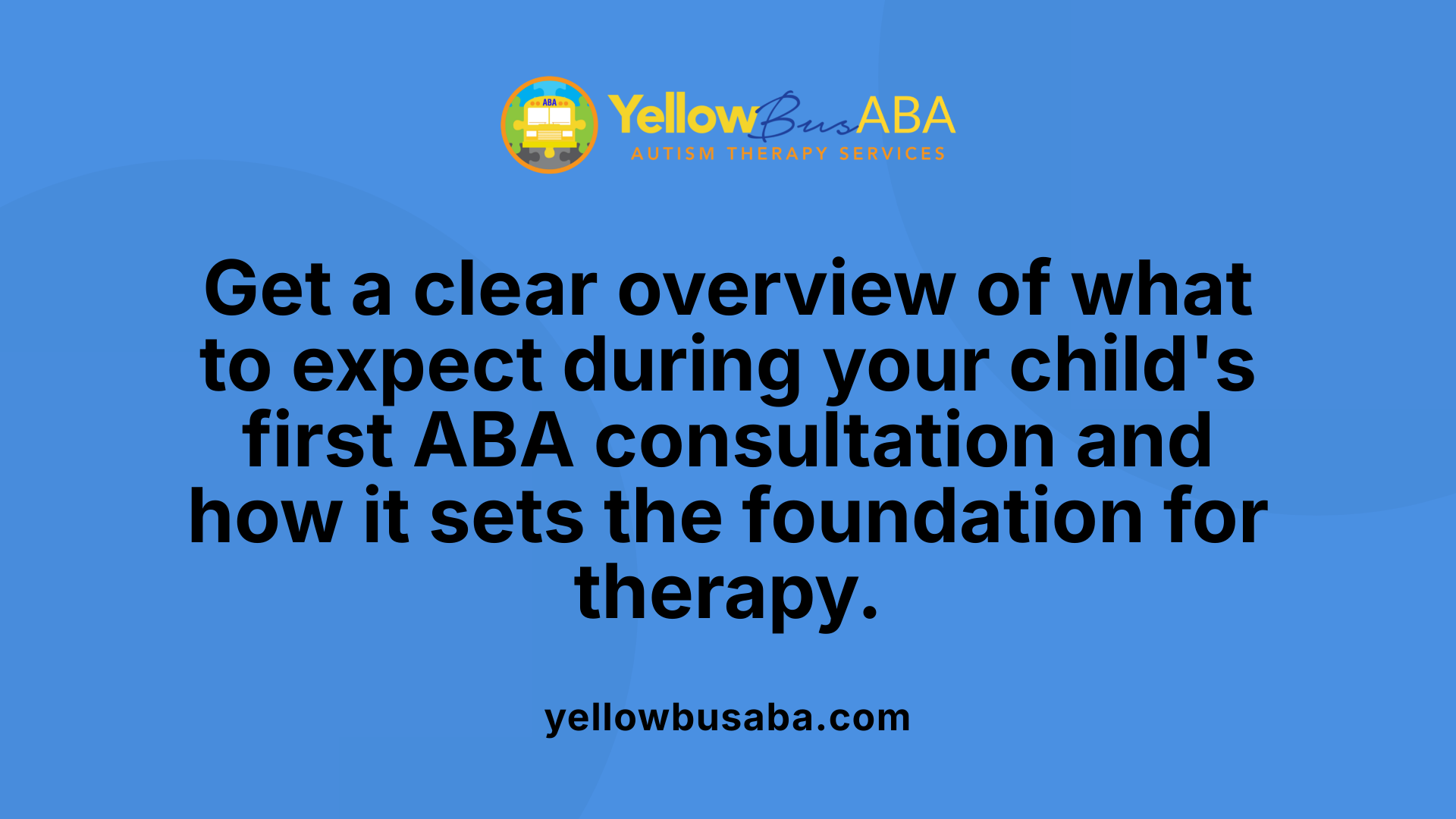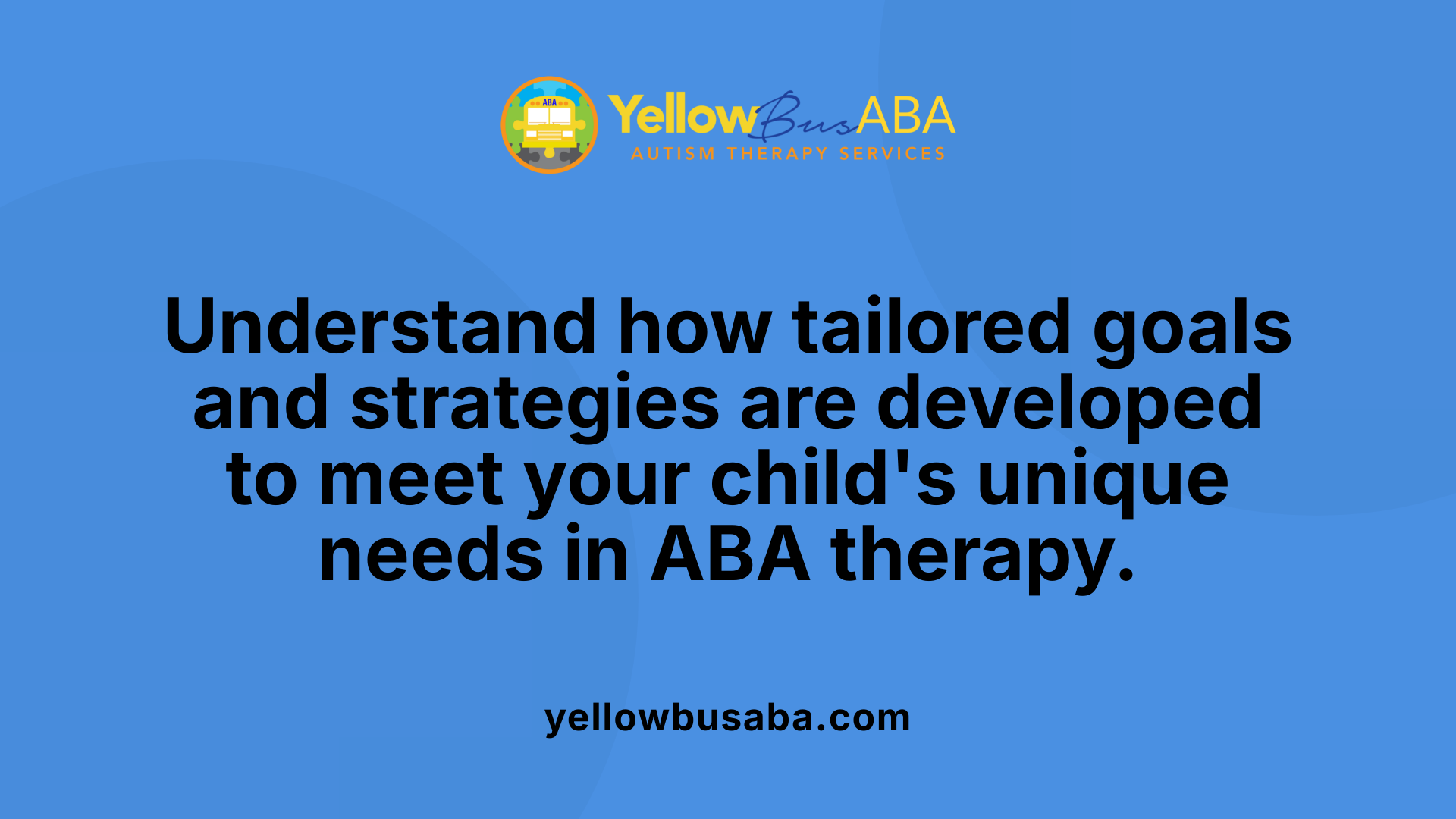What to Expect During Your First ABA Consultation
November 21, 2025
Navigating Your First Step into ABA Therapy: What to Know

Introduction to the ABA Consultation Experience
Starting ABA therapy can feel overwhelming for families new to this approach. Understanding what happens during the first consultation can help prepare you for a productive and reassuring experience. This article guides you through what to expect during your initial ABA consultation, explaining the therapy's foundations, the roles of professionals involved, assessment processes, treatment planning, and how families participate actively in the journey ahead.
Understanding ABA Therapy: Foundations and Goals

What is Applied Behavior Analysis (ABA) therapy?
Applied Behavior Analysis (ABA) therapy is a scientifically grounded approach to understanding and modifying behavior. Rooted in the science of learning and behavior, ABA focuses on increasing positive, helpful behaviors while reducing harmful or non-productive behaviors. It employs methods such as positive reinforcement, prompting, and task analysis to shape behavior effectively.
What are the core goals of ABA therapy?
ABA aims primarily to promote socially significant behaviors including communication, social interaction, and daily living skills. Simultaneously, it seeks to decrease behaviors that may interfere with learning or daily functioning. ABA programs carefully tailor goals to individual needs, ensuring progress in areas like language, attention, and problem behavior reduction.
What scientific evidence supports ABA?
ABA is recognized as an evidence-based best practice by major health authorities, such as the US Surgeon General and the American Psychological Association. Research indicates that intensive, long-term ABA therapy can lead to meaningful improvements in intellectual functioning, language, social skills, and independent living. It emphasizes continuous measurement and adjustments to maximize effectiveness.
This combination of scientific validation, individualized treatment, and structured behavioral strategies makes ABA one of the most effective therapies available for supporting individuals, notably those with autism spectrum disorder, to improve their quality of life.
How ABA Therapy Supports Individuals with Autism

How can ABA therapy benefit individuals with autism?
ABA therapy offers substantial benefits for individuals with autism by enhancing communication, social skills, and daily living abilities while decreasing problematic behaviors. This therapy is rooted in scientific principles of behavior and learning, utilizing positive reinforcement to encourage desired behaviors effectively.
What improvements can be seen in communication, social skills, and reduction of challenging behaviors?
Through individualized treatment plans, ABA therapy targets vital areas such as language development, social interaction, attention, and focus. It also addresses and reduces harmful or disruptive behaviors. Research shows that consistent and intensive ABA therapy can lead to improvements in intellectual functioning and social functioning. This holistic approach helps individuals develop meaningful skills for everyday life.
Where and how is ABA therapy provided?
ABA is a highly flexible form of therapy that can be delivered in multiple environments such as at home, in schools, or community settings. Therapy sessions can be one-on-one or in groups, tailored to the preferences and needs of the individual. This adaptability ensures that learning opportunities occur in natural environments, enhancing generalization and maintenance of acquired skills.
Why is early intervention important in ABA therapy?
Starting ABA therapy early, preferably before age six, is crucial for maximizing developmental outcomes. Early intervention grants individuals with autism a stronger foundation for independence and social functioning. By addressing challenges as soon as possible, ABA therapy helps set the stage for continual growth and improved quality of life.
Who Provides ABA Therapy? Qualifications and Roles

Various professionals involved in ABA therapy
ABA therapy is delivered by a team of trained professionals, each playing a crucial role in the therapy process. The primary providers include Board Certified Behavior Analysts (BCBAs), Board Certified Assistant Behavior Analysts (BCaBAs), Registered Behavior Technicians (RBTs), and Behavior Therapists.
Training and certification of BCBAs, BCaBAs, and RBTs
Board Certified Behavior Analysts (BCBAs) hold a master's degree or higher, complete extensive supervised fieldwork, and pass a rigorous certification exam. Some hold a doctoral degree, earning the BCBA-D credential. They are responsible for designing and overseeing individualized ABA programs.
Board Certified Assistant Behavior Analysts (BCaBAs) typically have an undergraduate degree and have completed specialized coursework and supervised training. They work under the supervision of BCBAs to support therapy implementation.
Registered Behavior Technicians (RBTs) are paraprofessionals who complete specific training and a competency exam. They provide one-on-one therapy directly with clients under BCBA or BCaBA supervision.
Many states require providers to be licensed or meet credentialing standards to ensure quality and ethical care.
Role of each provider in the therapy process
- BCBAs develop initial assessments, create and adjust treatment plans, and monitor overall therapy progress.
- BCaBAs assist with implementing therapy strategies, documenting client progress, and supporting BCBAs in clinical oversight.
- RBTs and Behavior Therapists deliver daily therapy sessions, use reinforcement strategies, collect data, and engage clients in targeted skill-building activities.
Together, these professionals collaborate closely with families and other caregivers to deliver personalized ABA interventions that support meaningful skill development and behavioral improvements.
The Initial ABA Consultation: What Happens?

Purpose of the First Consultation
The initial ABA consultation is a foundational step in starting therapy. It aims to understand the child's unique needs, strengths, and challenges. This meeting sets the stage for building a tailored treatment plan that addresses specific behavioral and developmental goals.
Introductions and Rapport Building
During the first meeting, families meet the behavior consultant, typically a Board-Certified Behavior Analyst (BCBA). Establishing rapport is essential for creating a comfortable space where open communication thrives. Positive interaction helps the child and family feel supported and engaged moving forward.
Gathering Information About the Child’s Needs and Strengths
The behavior consultant asks detailed questions about the child's behaviors, communication skills, social interactions, and daily routines. This conversation often involves parents and caregivers sharing developmental history and specific concerns, offering valuable insight into the child’s environment and behavior patterns.
Initial Assessments and Observations
Consultants may conduct preliminary observations during the session to better understand the child's responses and behaviors in a natural setting. They might also use informal assessments to identify areas such as communication abilities, social skills, and problem behaviors. This helps lay the groundwork for a comprehensive evaluation.
Parent and Caregiver Involvement
Active participation from parents and caregivers is crucial at this stage. Their input informs goal setting and strategy development. Consultants explain the therapy process and encourage family involvement to ensure consistency and support across all environments, enhancing therapy effectiveness.
Comprehensive Assessment During Your First ABA Meeting
What Happens During the Initial ABA Assessment?
The first meeting with a behavior analyst marks the start of the ABA therapy journey. It involves a thorough evaluation designed to understand your child's unique strengths and challenges. This detailed assessment is crucial to create a tailored ABA therapy plan.
How Are Parents and Caregivers Involved?
Interviews with parents and caregivers play a central role. These discussions provide valuable insights into your child's developmental history, preferences, and typical behaviors across different environments. Your input helps shape the goals and strategies that will guide therapy.
How Is the Child Observed?
The behavior analyst observes the child in various settings, such as at home or during play, to see how they interact with others and respond to different situations. This observation helps identify behaviors that may need support or encouragement.
What Testing Is Conducted?
A combination of standardized and informal tests evaluates key skills such as communication, social interaction, play, and daily living abilities. These assessments give a clear picture of your child's current development and skill levels.
What Is a Functional Behavior Assessment (FBA)?
An important part of the evaluation is the Functional Behavior Assessment. The FBA looks closely at specific behaviors by analyzing what happens before (antecedents), during, and after (consequences) the behavior. Understanding these triggers helps inform effective intervention strategies.
The comprehensive initial assessment sets the foundation for a personalized and effective ABA therapy plan tailored specifically to your child's needs and goals.
Developing a Personalized ABA Treatment Plan

Using assessment results to tailor therapy goals
An effective ABA therapy program begins with a detailed assessment that identifies the child’s unique strengths, challenges, and developmental needs. These results guide the creation of therapy goals that are tailored specifically to foster growth in areas where support is needed most. By leveraging these insights, the treatment plan targets meaningful skills that improve the child’s daily functioning.
Setting individualized objectives for communication, social skills, and behavior
The treatment plan sets specific, measurable objectives across key domains including communication, social interactions, self-care, play, and motor and academic skills. These goals aim to increase helpful behaviors such as language use and social engagement, while decreasing harmful or non-learning behaviors. Customizing objectives ensures that therapy remains relevant and motivating.
Incorporating child's interests and preferences
A personalized plan takes into account the child’s interests and preferences to design engaging activities and reinforce participation. Using preferred toys, games, or topics helps build a positive therapeutic relationship and enhances motivation for learning new skills.
Designing reinforcement strategies and interventions
Central to ABA is the use of positive reinforcement—rewarding desired behaviors to encourage their repetition. The plan outlines specific reinforcement strategies, tailored to what the child values, such as praise, tokens, or access to preferred activities. Intervention techniques blend structured teaching sessions with natural environment learning opportunities, ensuring meaningful and functional skill development.
Planning data collection and progress monitoring
Regular data collection is essential for tracking the child’s progress toward each goal. The treatment plan includes clear methods for documenting behavior changes and skill acquisition during sessions. This ongoing monitoring enables therapists to make informed adjustments, ensuring that interventions remain effective and aligned with the child’s evolving needs.
| Aspect | Description | Importance |
|---|---|---|
| Assessment-Driven Goals | Use of detailed evaluation results to create targeted objectives | Personalizes therapy for meaningful outcomes |
| Individualized Objectives | Setting specific goals in communication, behavior, and social skills | Addresses the child's unique developmental areas |
| Child-Centered Reinforcement | Incorporating preferred rewards and interests to motivate | Enhances engagement and positive relationship-building |
| Data Collection & Monitoring | Systematic recording of progress to guide therapy adjustments | Ensures therapy adapts to ongoing developmental needs |
| Intervention Design | Combining structured and naturalistic teaching strategies with positive reinforcement | Promotes skill acquisition and generalization across settings |
What ABA Therapy Sessions Look Like After Consultation
Typical structure of ABA sessions
ABA therapy sessions are carefully structured to maximize learning and engagement. Each session usually begins with a warm-up activity designed to help the child relax and prepare to participate fully. Following this, therapists guide the child through a series of targeted activities focused on specific skills such as communication, social interaction, play, or daily living skills.
Starting with warm-up activities and engagement
The warm-up is an essential part of the session as it helps to establish a positive tone and readiness. These activities are often playful and aligned with the child's interests, making the transition into more focused tasks smooth and enjoyable.
Use of positive reinforcement during activities
A core strategy throughout ABA sessions is positive reinforcement. This involves providing praise, rewards, or other valued incentives immediately after a desired behavior to increase the likelihood that the behavior will occur again. Reinforcement is tailored to each child’s preferences, ensuring motivation is maintained.
Strategies for building therapist-child rapport
Building a trusting and positive relationship between the child and therapist is vital. Therapists use play, shared interests, and consistent positive interactions to establish rapport, which helps the child feel safe and engaged in therapy.
Consistent schedules and routine for reducing anxiety
ABA therapy emphasizes routine and consistent scheduling. Predictable session times and structures help reduce anxiety and confusion for the child, creating an environment conducive to learning and skill development.
Role of Families and Caregivers in ABA Therapy
Active Family Involvement During and After Consultation
Families play a vital role from the very beginning of the ABA therapy process. During initial consultations, parents and caregivers share valuable insights about the child's strengths, challenges, and daily behaviors. This active participation helps shape personalized goals and strategies that align with the child's unique needs.
Training Parents to Implement and Reinforce Strategies at Home
ABA therapy emphasizes equipping parents with practical skills to reinforce learning beyond therapy sessions. Through family training, caregivers learn to apply positive reinforcement, manage challenging behaviors, and support the child's development consistently in everyday activities.
Collaborative Approach Between Families and Therapists
Therapists and families work as partners, regularly communicating to monitor progress and adjust intervention plans. This collaborative relationship ensures therapy remains flexible and responsive to the child's evolving needs, fostering sustained growth over time.
Importance of Home Environment Preparation
Preparing the home environment facilitates a seamless transition of skills from therapy to daily life. Modifying spaces to support learning and reducing distractions creates a supportive atmosphere that reinforces targeted behaviors and promotes independence.
Ongoing Communication and Support
Frequent follow-up sessions and open communication channels allow families and therapists to review accomplishments, troubleshoot challenges, and celebrate successes together. Continuous support strengthens the child's development and empowers caregivers to confidently sustain therapy benefits at home.
Addressing Concerns and Ethical Considerations in ABA Therapy
Are there any controversies or criticisms regarding ABA therapy?
Applied Behavior Analysis (ABA) therapy, although widely recognized as an effective treatment for autism spectrum disorders, has faced some controversies and ethical concerns. Historically, some practices within ABA were criticized for being too rigid or for prioritizing normalization over the individual's comfort and autonomy. In the past, aversive methods such as shock therapy were occasionally used, sparking significant ethical debate.
Modern ABA therapy has shifted significantly, emphasizing positive reinforcement and creating supportive environments. This approach encourages desired behaviors through rewards, fostering a respectful and nurturing atmosphere for learning and development.
Critics have also raised concerns about how ABA might impact a person's autonomy and self-expression. There is fear that, without careful application, ABA could suppress individual preferences or flexibility. Contemporary ABA recognizes these concerns and actively adapts to the unique needs of each individual. Programs are personalized, respecting sensory sensitivities and promoting self-determination.
Family-centered care is a cornerstone of today’s ABA practice. Families are closely involved in planning and implementing therapy, ensuring strategies align with the individual's lifestyle and values. Sensory-aware approaches also help accommodate differing sensory profiles, enhancing comfort and engagement.
Through these modern adaptations, ABA therapy strives to ethically support each person’s growth, independence, and overall quality of life.
Moving Forward With Confidence
Your first ABA consultation marks the critical beginning of a tailored journey toward meaningful improvements in behavior and skills. By understanding the principles of ABA therapy, the expertise of your providers, and the detailed assessments that guide personalized treatment plans, you can actively participate in fostering your child's growth. Remember, successful ABA therapy relies on collaboration, trust, and adaptation to evolving needs. Embracing these elements empowers families to build a strong foundation for positive change and greater independence.
References
- Applied Behavior Analysis (ABA)
- Autism ABA Therapy Evaluations: What to Expect and How ...
- First Meeting with a Behavior Consultant
- What to Expect on the First Day of ABA Therapy?
- ABA Therapy Journey: What to Expect from Start to Finish
- What to Expect During an ABA Therapy Evaluation
- How to Get Started with ABA Therapy: A Step-by-Step Guide




.avif)

